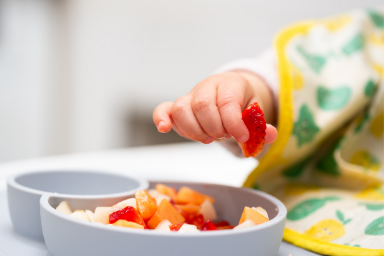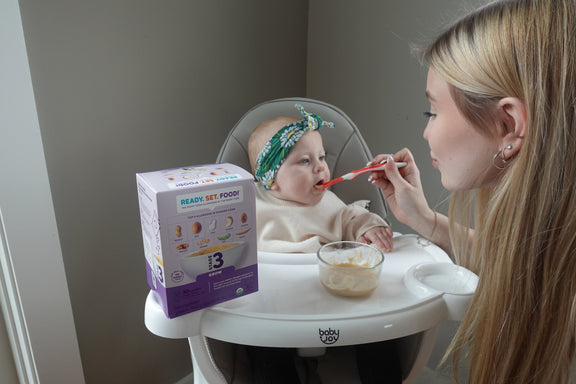After introducing peanut early (in baby’s first year), how can you keep safely feeding your toddler peanut? We’ve got you covered with these yummy and healthy peanut recipes for toddlers.
As clinical guidelines – and the LEAP study that inspired them – have shown, feeding your child safe forms of peanut early and often is key. This consistent exposure to peanut should start in baby’s first year, and continue over several years.
But after introducing peanut early (such as with Ready. Set. Food!), how can you continue to feed peanut to your toddler (your 1 to 3 year old)? We’ve got you covered with our top peanut recipes for toddlers.
Continuing To Feed Your Child Peanut
Before we dive into the recipes, let’s cover what parents need to know about continuing exposure to peanut.
The landmark LEAP study has shown that continued peanut exposure is key.
In the groundbreaking LEAP study (Learning Early About Peanut Allergy study), over 600 children ages 4-11 months were randomly assigned to one of two groups.
- The first group ate foods containing peanut regularly – at least three times per week – until they reached 5 years of age.
- The second group avoided peanut completely until they reached 5 years of age
The study’s results showed that the children who started eating peanut early, and who kept eating peanut regularly for over four years, were 85% less likely to develop a peanut allergy.
Thus, the LEAP study showed how important it is to continue feeding young children peanut.
Medical guidelines support continued peanut feeding
The LEAP study influenced several sets of medical guidelines, including guidelines from the U.S. Department of Agriculture (USDA) and the American Academy of Allergy, Asthma, and Immunology (AAAAI) The AAAAI guidelines recommend introducing peanut-containing foods to babies starting before age one, and continuing to feed peanut and other common allergenic foods to toddlers.
But don’t feed toddlers whole peanuts or peanut butter
It’s not safe to feed your child certain forms of peanuts, though, because they are choking hazards. According to the AAAAI guidelines, “whole, shelled peanuts and lumps of peanut butter should not be given to children younger than 5 years due to the risk of choking.”
Avoid feeding the following peanut foods to children under age 5:
- Any whole peanuts
- Any larger pieces of chopped peanuts
- Any chunky peanut butter
- Smooth peanut butter by itself (that isn’t watered down or mixed in a recipe)
Use safe forms of peanut instead.
There are plenty of safe ways to feed peanut to your toddler, including mixed in a recipe.
Try using these:
- Peanut flour or peanut powder (finely ground peanuts)
- Smooth peanut butter that’s diluted – meaning watered down or mixed in a recipe
Skip forms of peanut with added sugar, and avoid peanut recipes that include added sugar as well. Toddlers (especially toddlers age 2 and under) don’t need added sugar.
Also, make sure the peanut flour, peanut powder or peanut butter is free from artificial additives.
Now that we’ve covered the essentials, let’s dive into these yummy peanut recipes.
1. Sweet Peanut Buttery Potato

Inspired by Love and Zest.
Ingredients:
- 1 sweet potato
- Sliced bananas
- Halved blueberries
- 2 teaspoons smooth peanut butter
- 2 teaspoons hot water
Instructions:
- Microwave the sweet potato for 5 minutes or until it’s soft.
- Cut open the sweet potato.
- Mix the peanut butter and hot water together so it becomes a drizzle.
- Top the sweet potato with the bananas and blueberries.
- Then, drizzle all the thinned peanut butter on top.
- Serve to your toddler.
2. Peanut Butter, Pumpkin, and Yogurt Dip

Inspired by the National Peanut Board
Ingredients:
- 3 tablespoons peanut powder
- ½ cup plain yogurt with no added sugar
- ¼ cup pumpkin puree (100% pumpkin)
- ¼ teaspoon cinnamon
- Cut fruits or veggies for dipping
Instructions:
- Mix all ingredients together in a bowl until well blended.
- Cut up fruits or veggies for your child to dip in the peanut mixture. Try:
- Sliced strawberries
- Thinly sliced apples
- Carrot sticks (steamed for toddlers under age two; toddlers over age two may be able to handle thinly sliced raw carrot sticks in matchstick size)
- Matchstick-sized celery sticks
- Cucumber slices
3. PB Beet Muffins

Inspired by MJ and Hungryman.
Ingredients:
- ½ cup rolled oats
- 3 small cooked beets
- ½ cup smooth peanut butter
- ¾ cup chickpeas with no salt added (rinsed and drained)
- 1 ½ ripe bananas
- 1 teaspoon cinnamon
- ½ teaspoon baking soda
- 1 teaspoon baking powder (no aluminum)
Instructions:
- Preheat your oven to 350 degrees Fahrenheit.
- In a blender or food processor, pulse the oats into a flour.
- Add all the other ingredients into the blender or food processor, and blend with the oats until smooth.
- Fill the muffin pan about ½ full with the batter.
- Bake for 20-25 minutes or until a toothpick comes out clean.
- Let cool completely, then serve
4. Healthy Peanut Butter, Banana, and Oat Breakfast Cookies

Inspired by Cali Girl Cooking.
Ingredients:
- ½ cup smooth peanut butter
- 2 ½ cups rolled oats
- 3 bananas
- 1 egg
- 3 teaspoons chia seeds
- 1 teaspoon ground cinnamon
Instructions:
- Preheat your oven to 350 degrees Fahrenheit.
- In a mixing bowl, mash up the bananas with a spoon until you don’t have any large chunks.
- Add in all the other ingredients and mix together until they’re well-combined.
- Using a spoon, scoop out dough mounds and evenly place them on a cookie sheet.
- Smash each dough mound a bit.
- Bake for 15-18 minutes
- Let cool for 10 minutes, then serve.
- You can freeze the healthy cookies for up to three months.
5. Plant-Based Peanut Butter Stew

Inspired by MJ and Hungryman.
Ingredients:
- 1 tablespoon olive oil
- 1 medium onion, diced
- 2 teaspoons cumin
- 2 teaspoons garlic powder
- ½ teaspoon cinnamon
- ¼ teaspoon smoked paprika
- ½ cup natural style peanut butter
- 1 medium sweet potato, diced (can substitute in carrots, squash, or potatoes)
- ½ of a medium cauliflower, chopped (can substitute in broccoli – or any other chopped veggie)
- 1 can chickpeas with no salt added
- 1 can diced tomatoes with no salt added
- 2 cups vegetable broth (or, 1 cup broth and 1 cup water)
- 2 cups kale or spinach (optional)
- Whole grains to serve the stew with (optional)
Instructions:
- Heat the oil in a large pot, over medium heat.
- Add the onion and garlic powder, and cook until the onion is soft.
- Add the spices and cook for another 1-2 minutes.
- Add all the other ingredients, except for the spinach.
- Bring the ingredients to a boil.
- Stir until the peanut butter dissolves.
- Cover the pot and keep heating the stew on medium-low.
- Simmer for 15-20 minutes or until the veggies are softened.
- Add the spinach.
- Simmer for 3-5 more minutes, uncovered.
- Serve – with whole grains, if desired. This is a great dish for your whole family!
6. Coco-Nutty Peanut Butter Chicken

Inspired by Love and Zest. You’ll need a slow cooker or Instant Pot for this recipe.
Ingredients:
- 1 can coconut milk
- ¼ cup smooth peanut butter
- 1 tablespoon ground turmeric
- 1 pound chicken
- Cooked veggies, to serve the chicken with (optional)
Instructions:
- Add all the ingredients to your slow cooker or Instant Pot.
- With the lid closed, cook the chicken.
- This will take 6 hours if you’re using a slow cooker.
- If you’re using an Instant Pot, use the poultry setting (or 12 minutes on high pressure).
- Once the chicken is fully cooked, remove it from the pot. Shred it or cut it into small pieces.
- Stir the remaining sauce in the pot so it’s creamy.
- Pour the sauce over the chicken and serve it to your toddler. Try serving it alongside (or mixed with) some of their favorite cooked veggies.
7. PB Veggie Waffles

Inspired by MJ and Hungryman. If you don’t have a waffle iron, that’s ok – you can cook these as pancakes instead!
Ingredients:
- ¼ cup rolled oats
- 1 ½ cups whole wheat flour
- 2 teaspoons baking powder
- 1 teaspoon cinnamon
- ⅓ cup smooth peanut butter
- ½ cup mashed ripe banana
- ½ cup shredded carrots
- ½ cup shredded zucchini
- 2 medium eggs (lightly beaten)
- 1 ½ cups whole milk
- Healthy toppings – see below for suggestions
Instructions:
- Mix the oats, flour, cinnamon and baking powder together in a large bowl.
- Squeeze the carrots and zucchini to get as much moisture out as possible.
- Mix the carrots, zucchini, peanut butter, banana, eggs, and milk in a separate bowl.
- Mix the wet and dry ingredients together – but don’t overmix.
- Let the batter sit for about 10 minutes.
- Use a waffle iron to cook the batter, following the instructions on the iron. OR, cook the batter as pancakes.
- Top the waffles as desired. Here are some suggestions:
- Watered down smooth peanut butter, as a drizzle
- Honey, as a drizzle
- Plain (unflavored) yogurt with no added sugar
- Cut strawberries, raspberries or blueberries
- Thinly sliced apples
- Banana or kiwi slices
- Diced peaches or mango
- Shredded cheese
- Avocado

The Window Of Opportunity For Introducing Peanut: New Study Findings From the LEAP and EAT Trials
Results from the landmark LEAP and EAT studies have shown that intr...

Best Finger Foods For Babies (And When To Start Finger Foods)
When to move beyond the spoon and start baby's journey with finger ...

6 Reasons Why You Should Introduce Allergens
Landmark studies and medical guidelines recommend that you introduc...

7 Ways to Feed Your Toddler More Iron
Iron is an essential mineral for your toddler’s brain health and ov...

How To Know If My Toddler Is Getting Enough Protein?
Protein supports your toddler’s growth, helps build strong bones an...

How Much Milk Should Your Toddler Drink?
How much milk should your toddler drink in a day? Find out the reco...
All health-related content on this website is for informational purposes only and does not create a doctor-patient relationship. Always seek the advice of your own pediatrician in connection with any questions regarding your baby’s health.
These statements have not been evaluated by the Food and Drug Administration. Products are not intended to diagnose, treat, cure or prevent any disease. If your infant has severe eczema, check with your infant’s healthcare provider before feeding foods containing ground peanuts.







